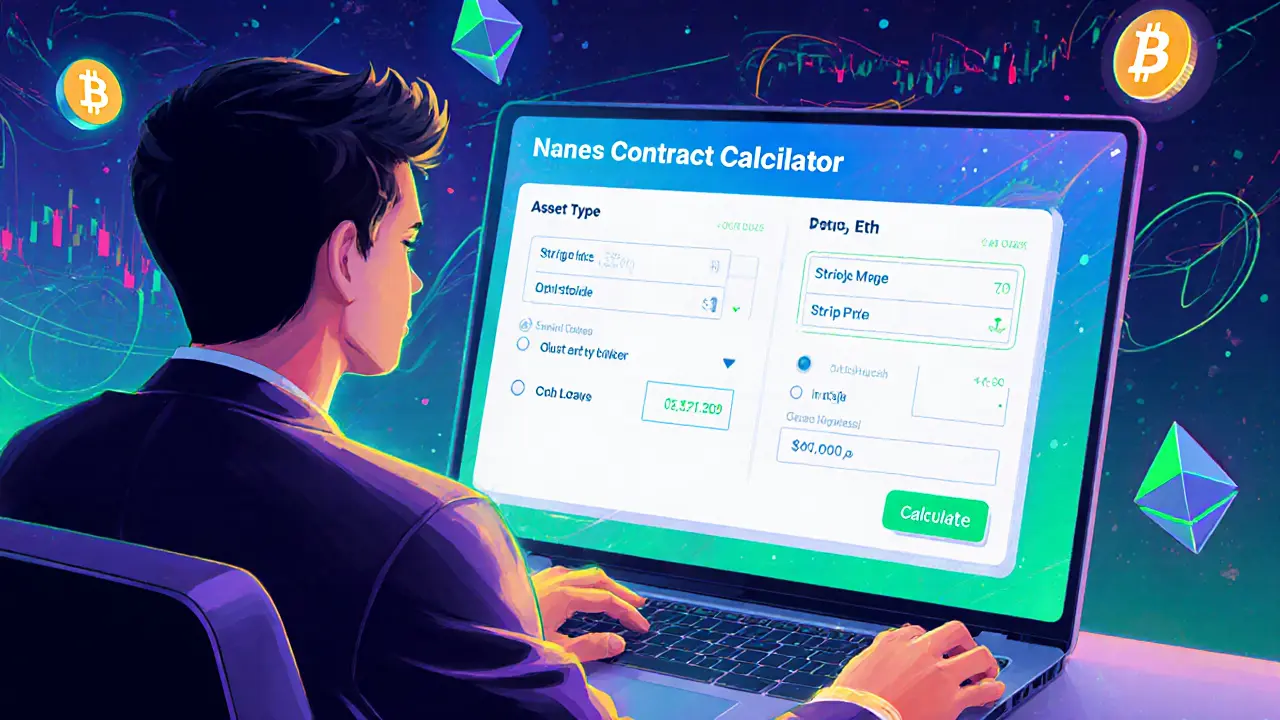Thalex Contract Calculator
Contract Information
Fee Structure: Flat 0.01% maker-taker fee (lowest in the market).
Settlement: Daily at 08:00 UTC using Thalex index.
Margining: Portfolio-level margining for improved capital efficiency.
Profit/Loss Analysis
Thalex is a crypto‑derivatives exchange that focuses on options, futures and perpetual contracts for Bitcoin and Ethereum. Launched with a EUR7.5million SeriesA round in 2022, the platform leans on heavy‑weight backers like Bitfinex, Flow Traders and Wintermute to promise institutional‑grade reliability.
Key Takeaways
- Offers Bitcoin and Ethereum options settled in stablecoins (USDt/USDC)
- Flat 0.01% maker‑taker fee, with extra discounts via RFQ for large multi‑leg orders
- European‑style contracts, minimum size 0.1BTC or 1ETH
- Portfolio‑level margining boosts capital efficiency for hedged strategies
- Backed by major crypto institutions, but regulatory status remains unclear
Platform Overview
The exchange’s UI targets sophisticated traders. Order books for each contract are deep, and the platform provides an atomic strategy builder that lets you bundle calls, puts, futures and perpetuals without manually sending RFQs. Settlement happens daily at 08:00UTC, using the platform’s own Thalex BTCUSD and Thalex ETHUSD indices, which are weighted averages of major spot‑market order‑book data.
Contract Specs and How They Work
Both Bitcoin and Ethereum contracts are denoted by a ticker that encodes expiry, strike and side. For example, BTC-15Oct24-30000-C is a call option expiring on 15Oct2024 with a $30,000 strike. Each contract represents 1BTC (or 1ETH) and is valued at $1 per index point.
- Bitcoin options: minimum order 0.1BTC, volume tick 0.1BTC, price tick $5.
- Ethereum options: minimum order 1ETH, volume tick 1ETH, price tick $1.
- All contracts settle in USDt (Tether) or USDC, allowing you to keep collateral entirely on‑chain.
Settlement price (EDSP) is a time‑weighted average of the index between 07:30UTC and 08:00UTC on expiry day. This approach reduces manipulation risk compared to a single‑point snapshot.
Fee Structure
Thalex advertises a flat 1basis‑point (0.01%) fee for both makers and takers. That’s among the lowest in the market. For traders who regularly send multi‑leg RFQs, the platform offers rebate tiers that can bring the effective fee down to zero for very high volumes.
Unlike many competitors, there are no hidden maker‑taker differentials, and the fee applies uniformly whether you trade a single‑leg option or a complex spread.
Risk Management and Margining
Thalex uses a portfolio‑based margin model. Rather than requiring independent margin for each contract, the system looks at net delta and vega across your entire position. This can free up up to 30% of capital for hedged strategies.
If a position’s margin falls below the required threshold, the platform triggers an automated delta‑hedge to limit market impact, followed by a liquidation auction that matches remaining orders at the best available price.
The risk engine also incorporates “wing risk” buffers to ensure that extreme moves in one direction don’t instantly wipe out collateral.

Liquidity & Market Maker Scheme
Thalex’s market‑maker program offers competitive fee rebates, protection against adverse selection, and direct connectivity via FIX and WebSocket APIs. The backing investors - notably Bitfinex, Flow Traders, Wintermute - provide deep liquidity pools that keep spreads tight even under volatile conditions.
Regulatory Status and Institutional Backing
When Thalex filed its SeriesA round in 2022, it announced that it was seeking regulatory authorization in the European Economic Area. As of the last public update (mid‑2025), a formal licence has not been publicly confirmed, so potential users should conduct their own compliance checks.
The institutional roster is a strong signal of confidence: Bitfinex brings exchange experience, Flow Traders contributes market‑making expertise, while IMC offers electronic trading infrastructure. Together they aim to position Thalex as a “trust‑less yet institution‑friendly” venue.
Competitive Landscape
Thalex operates in a niche dominated by established players such as Deribit, BitMEX and the now‑defunct FTX. Below is a quick side‑by‑side comparison.
| Feature | Thalex | Deribit | BitMEX |
|---|---|---|---|
| Underlying assets | BTC, ETH (stablecoin‑settled) | BTC, ETH (USD‑settled) | BTC, ETH (USD‑settled) |
| Contract style | European‑style options | European‑style options | American‑style futures |
| Minimum order | 0.1BTC / 1ETH | 0.01BTC / 0.1ETH | 0.001BTC / 0.01ETH |
| Fee (maker/taker) | 0.01% flat | 0.02% maker / 0.05% taker | 0.025% maker / 0.075% taker |
| Collateral options | BTC, ETH, USDt, USDC | BTC, ETH, USDT | BTC, ETH |
| Regulatory status | Seeking EU licence (2025) | Registered in Panama (no EU licence) | Registered in Seychelles |
Pros and Cons
- Pros
- Ultra‑low 0.01% fee.
- Stablecoin settlement reduces fiat on‑ramps.
- Portfolio margining improves capital efficiency.
- Strong institutional liquidity backing.
- Cons
- Higher minimum contract sizes deter retail traders.
- Regulatory clearance still pending.
- Platform UI is geared toward professional users; steep learning curve.
How to Get Started
- Visit the official website and click “SignUp”.
- Complete KYC - you’ll need a government ID and proof of residence.
- Deposit collateral: BTC, ETH, USDt or USDC. Minimum deposits are 0.1BTC or 1ETH for trading.
- Navigate to the “Derivatives” tab, select the asset (BTC or ETH), and choose your expiry.
- Use the strategy builder to create spreads, or send a manual RFQ for large custom orders.
- Monitor margin levels in the dashboard; the platform will auto‑hedge when thresholds are breached.
Once you’re comfortable, you can explore the API for algo‑trading. The API follows REST conventions and supports FIX for ultra‑low‑latency firms.
Final Thoughts
If you’re an experienced derivatives trader looking for a low‑cost, stablecoin‑settled venue with deep institutional liquidity, Thalex is worth a serious test run. Its fee model and portfolio margining are hard to beat, but the higher entry thresholds and unresolved regulatory standing mean it’s not yet a plug‑and‑play option for newcomers.

Frequently Asked Questions
What collateral can I use on Thalex?
You can fund your account with Bitcoin, Ethereum, Tether (USDt) or USD Coin (USDC). The platform treats each as eligible margin for both options and futures.
How does Thalex calculate settlement prices?
The Exchange Delivery Settlement Price (EDSP) is a time‑weighted average of the Thalex BTCUSD or ETHUSD index between 07:30UTC and 08:00UTC on the expiration day.
Is Thalex regulated in the EU?
As of October2025, Thalex is still seeking a formal EU licence. Users should perform their own compliance checks before depositing significant funds.
Can I trade American‑style options on Thalex?
No. Thalex only offers European‑style options, which can only be exercised at expiry.
What are the fee rebates for large RFQ orders?
Traders that submit multi‑leg RFQs exceeding €1million in notional volume can qualify for fee rebates that bring the effective rate close to 0%.


Janelle Hansford
Hey folks, great rundown on Thalex! The ultra‑low 0.01% fee really stands out, especially for those of us juggling multiple strategies. I love that they offer portfolio‑level margining – it can free up a nice chunk of capital. If you're new, start small and get comfy with the UI before scaling up.